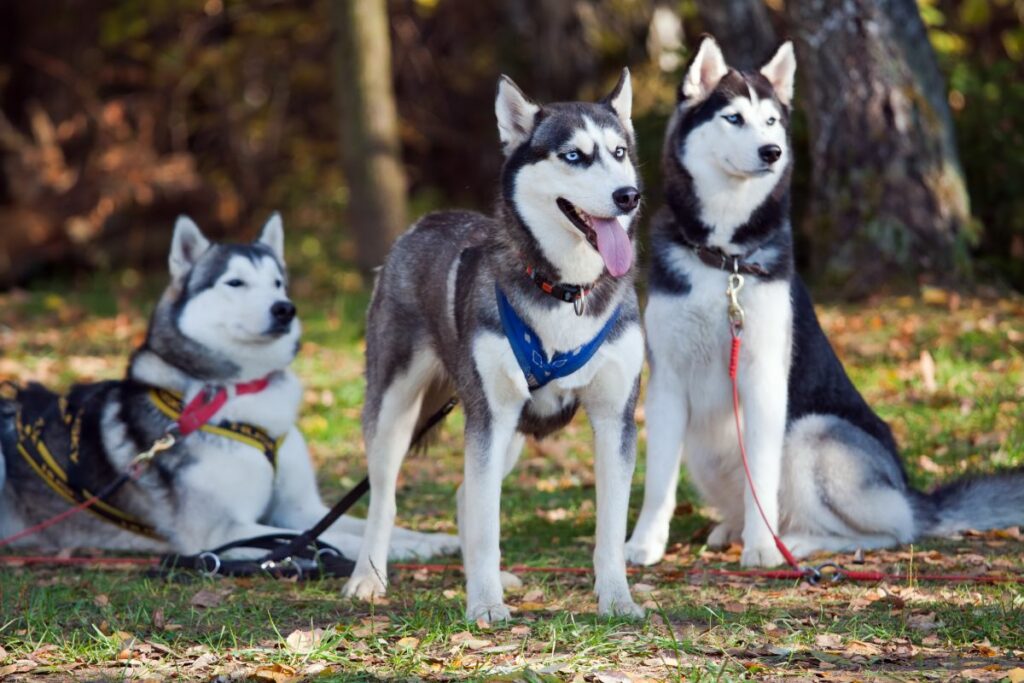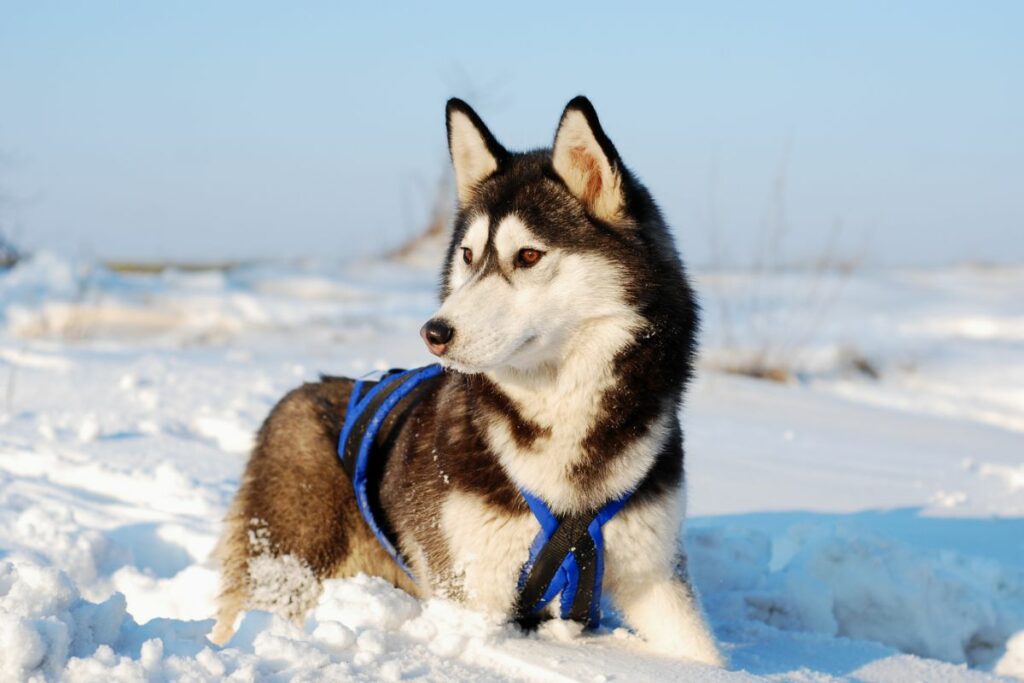Siberian huskies used to be uncommon dogs to have as a pet, but their beautiful appearance and their intelligent nature have meant that they’ve risen in popularity.
Now, Siberian huskies can be found as household pets all over the world.

If you’re considering a Siberian husky pup, it’s important to understand everything you can about the breed before you make the commitment.
In this guide, we’ll give you some background on the husky, share insights on their personality, and give you a heads-up on some common problems associated with the breed.
Let’s get into it.
Breed Facts About Siberian Huskies
The Siberian husky is a medium sized breed of dog from the Spitz family.
These are working dogs, originally bred by the Chukchi people in Eastern Siberia to pull their sleds.
As such, they are strong, muscular, and fast. And this is why, in 1908, they were used for sled racing.
Their breeding as sled dogs means they are accustomed pack animals – this allows them to fit in well in the family setting.
Due to the cold conditions where these dogs originated, they have very thick, double coats – designed to protect them from the elements. Thanks to these coats, they can actually withstand temperatures as low as −60 °C (−76 °F).
Having such a thick coat doesn’t come without its problems, though – these dogs are big shedders, so you’ll need to follow a good grooming routine (but we will share more on that later).
Unlike many other dog breeds, although they can have brown eyes, they also often have blue eyes; sometimes, they may even have one blue eye and one brown eye!
They have upright ears and distinctive coat markings.
These wolf-like dogs come in a range of colors, including gray and white, black and white, sable and white, red and white, brown and white, agouti and white, pure white, pure black, and black, tan and white.
Huskies are often confused with Malamutes, but Alaskan Malamutes are much larger.
Siberian Husky Average Size, Lifespan And Key Life Stages
The Siberian husky has an average lifespan of 12-15 years. Later in this guide, we will cover some of the common health issues that can impact this dog’s lifespan.
Male Siberian huskies grow to be around 21-24 inches in height and 45 – 60 pounds (20 – 27 kg) in weight.
Female huskies weigh in at around 35 – 50 pounds (16 – 23 kg) and 20 – 22 inches in height.
Siberian huskies are puppies until the age of one year old. Until this point they need a diet that is designed especially for puppies, to ensure they get enough nutrition for these important growth stages.
Most huskies will reach their full height by around one year old, but they will need a few more months to fill out completely and reach their optimum adult weight.
Like many other medium sized dogs, a Siberian husky will be considered an adult dog between the ages of 1 and 7 years old.
After the age of 7, your Siberian husky will be considered a senior dog and its needs will change.
At this stage, it is advised to change your huskies’ diet to a senior blend to accommodate its need for extra glucosamine and vitamins and minerals to support an older dog.
Siberian Husky Personality
The Siberian husky is graceful and highly intelligent. As pack animals, they’re very social dogs. They’re also incredibly vocal, which can be a problem for some owners.
Huskies are friendly and playful, and they love human company, making them popular family dogs.
However, on the flip side, enjoying human company so much means that huskies struggle being left alone for long periods of time.
It’s common for huskies to suffer from separation anxiety and they can also become quite destructive as a result. Bearing this in mind, they are better suited to a household where someone is often home.
Huskies are very active dogs so they are compatible with families who enjoy spending time outdoors.
They can be considered quite high maintenance – and require plenty of grooming and exercise – which means they may not be suitable for new dog owners.

Caring For Your Siberian Husky
If your heart is set on bringing a Siberian husky into your family, it’s essential to research their diet, exercise, and grooming needs.
We’ll walk you through the huskies’ care needs below:
Diet
As we touched upon earlier, your Siberian huskies’ diet and nutritional requirements will change depending on its life stage. But, in general, huskies require a high protein diet as they are high-energy dogs.
In the wild, they are opportunistic eaters – meaning that they will feast on whatever food is available – and they will also hunt and feed on birds and small mammals.
As a domestic dog, the husky requires around 30-40% protein and 18-20% fat in their diet – this helps ensure they have enough energy and can maintain their muscle mass.
As puppies, your husky will need dry or wet food specifically developed for infant dogs. We recommend asking the breeder about the type of food they fed the litter so that you can provide continuity with the pup’s diet.
Puppies need more calories to fuel their growth. They also need more frequent meals compared to adult dogs so splitting their daily food allowance into three meals is recommended.
As adults, huskies require a good quality dry or wet food with high protein levels.
Due to their working dog background, many husky owners choose to feed a raw diet.
Whichever diet you choose for your adult husky, it’s important to consult with your veterinarian and introduce new foods slowly – over the course of a few weeks.
When your husky reaches its senior years, its dietary requirements will change again. Older dogs generally require fewer calories and increased levels of glucosamine to support joint health.
When it comes to treats, be sure that they don’t make up any more than 10% of your dog’s diet.
As dogs that need a high protein diet, huskies can benefit from lean beef, chicken and turkey. To check which human foods are safe for your dog, take a look at our guide here.
Exercise
Siberian huskies are high energy dogs and, as such, require plenty of exercise.
Adult huskies will need at least two hours of vigorous exercise a day, split into two or more trips out of the house.
While walks are fine, these dogs do benefit from more high energy exercise, so if you’re a runner, take your husky along with you.
As well as this, huskies need a good sized garden to play in and burn off some energy.
It’s important that your garden is secure and enclosed as these dogs are pretty adventurous and have been known to make a dash for freedom due to their inbuilt instinct to run.
As well as physical exercise, it’s important to keep these dogs mentally stimulated. Huskies are highly intelligent and require plenty of enrichment in the form of puzzle toys and playtime.
Getting the whole family involved in playing with your husky is a great way to keep your pooch engaged.
Although adult huskies need plenty of exercise, as pups, exercise should be provided more sparingly. At around 3 months old, they should have shorter play sessions to avoid too much strain on their body.
By the time they reach 6 months old, they can be introduced to longer walks and adventures.
Grooming
We mentioned earlier in this article that Siberian huskies have double coats, and thick fur, which means that they need a good grooming routine and require more maintenance than single-coated dogs like the pug, the shiba inu or the whippet.
You should aim to thoroughly brush your husky at least once a week, but brushing daily is better, if you can manage it.
Huskies usually experience a full shed twice a year, but they will continue to be heavy shedders between those times, so regular grooming can really help.
Deshedding brushes can be helpful for grooming these dogs, or you can use a wide-toothed comb followed by a paddle brush in your grooming routine.
You can bathe your husky every 3 to 4 months if necessary – they shouldn’t really require a bath more regularly than that as they are pretty clean dogs.
As well as brushing your Siberian husky regularly, it’s also recommend to clean their teeth.
Start introducing your husky to teeth cleaning as a pup and continue a regular brushing routine into adulthood.
Training
As smart dogs, and as pack animals, robust training is important. First time dog owners can find huskies difficult to train, but they should provide few problems for more experienced owners.
Start training your husky from a young age – focusing on rewarding good behavior, rather than punishing undesirable actions – and establish a pack hierarchy early on to gain your dog’s respect.
Other
As well as providing your Siberian husky with a high-quality diet, plenty of exercise, and a regular grooming routine, they will also need worming and flea treatments on a regular basis as well as vaccinations.
Your veterinarian will be able to advise on the right worming and flea treatments for your dog, as well as the frequency of vaccinations.

Common Siberian Husky Health Problems
Every breed of dog is susceptible to certain health concerns and the Siberian husky is no exception.
Below are some of the most common health problems associated with the breed:
Eye Problems
- Cataracts: Many older huskies often exhibit eyes with a hazy appearance. This is indicative of cataracts, which are notably prevalent among this breed, especially during their senior years. However, certain genetics can result in huskies developing cataracts at a much earlier age.
- Progressive Retinal Atrophy (PRA): PRA is a common husky ailment. This condition leads to blindness, stemming from the gradual deterioration of the retinas.
- Glaucoma: Glaucoma is common In huskies; it’s an excessive pressure accumulation within the eyes. This not only causes pain and discomfort but also poses a risk of vision impairment.
- Corneal Dystrophy: This is a hereditary eye disorder, characterized by the development of opaque or cloudy spots on the cornea due to abnormal tissue growth. It typically manifests in three forms, affecting either the superficial layers, the innermost layer, or involving lipid deposits in the cornea. The condition’s origin is largely linked to genetics. While it can cause some visual challenges, it’s generally mild compared to other eye disorders.
Skin And Joint Issues
- Hip Dysplasia: Hip dysplasia is common in Siberian huskies and occurs when the hip joints don’t fit perfectly together. This condition can result in joint stiffness, pain and discomfort. It can also lead to arthritis.
- Zinc-responsive Dermatosis: This is a skin condition resulting from either a zinc deficiency or the body’s inability to absorb zinc. Symptoms often include scaly skin, especially around the eyes and mouth, hair loss, and thickened paw pads.
Other Issues
- Hypothyroidism: Hypertension is high blood pressure that can be primary (unknown cause) or secondary (due to other health issues like kidney disease). If untreated, it can lead to heart disease, kidney damage, or blindness. Regular vet visits are crucial for early detection and treatment, which may include medications or dietary adjustments.
- Epilepsy: This condition is characterized by recurring seizures, which can be idiopathic (of unknown origin) or caused by underlying conditions. While the exact cause in huskies is often unclear, genetics may play a role. Manifestations range from mild twitching to severe convulsions. Regular veterinary consultations are essential for diagnosis and management, which may include anticonvulsant medications and lifestyle modifications.
In Summary
Siberian huskies make great family pets – especially for active households that enjoy going out for adventures.
They’re kind, smart, and loveable dogs that love human company. They benefit from an owner who is home much of the time and can suffer when left along for long periods.
They’re active dogs, so it’s important to bear this in mind before you commit to bringing a husky into the family.
In this guide, we’ve included the basics of husky care and have introduced you to some of the common complaints associated with this breed, but it’s important to speak to the breeders, and your vet, to get as much information as possible before you bring a new puppy into your home.
Ready for another breed guide? Take a look at our lowdown of the golden retriever.
- A Pawprint Pets Guide To Puppy Breeds: Siberian Husky - August 14, 2023
- A Pawprint Pets Guide To Puppy Breeds – Golden Retrievers - August 10, 2023
- Ding Ding – How To Teach Your Dog To Ring A Bell To Go Outside - August 7, 2023
